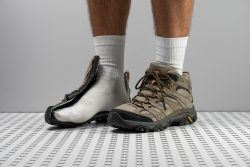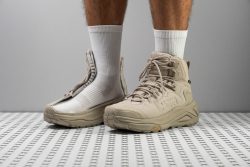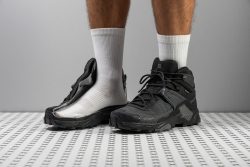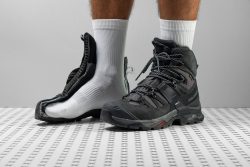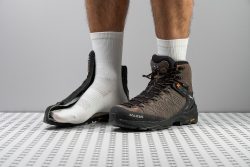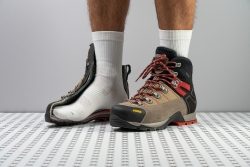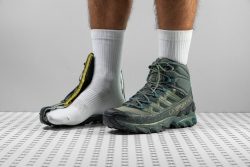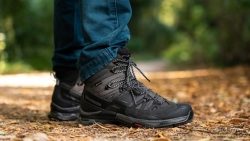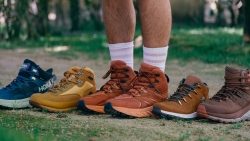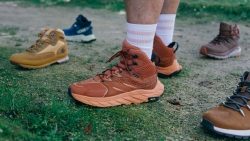7 Best Gore-Tex Hiking Boots in 2025
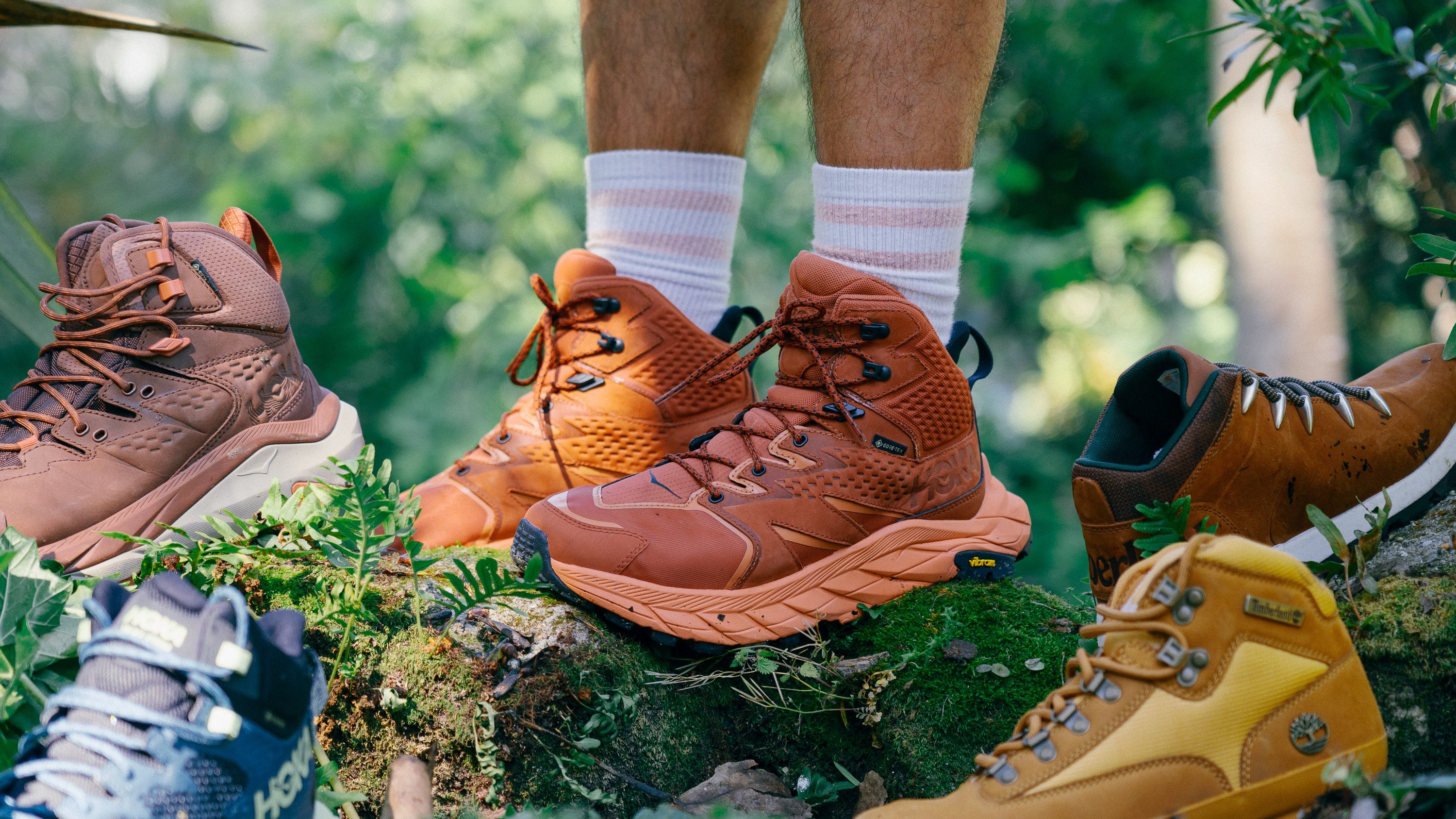
We buy shoes ourselves. We earn commissions when you buy through us, at no extra cost. Why trust us
Enjoy and conquer the great outdoors with these top-rated Gore-Tex hiking boots. A world-renowned and trusted technology in the outdoor footwear industry, Gore-Tex is a waterproof membrane that ensures all-around protection and comfort for all outdoorsy adventurers.
When your next planned hiking trips involve traversing through rainforests, shallow streams, or snowy trails, wearing the ever-dependable Gore-Tex boots is a smart decision. They will keep your feet dry, well-protected, and comfortable from the moment you leave the base camp to the highest peaks.
To make our top recommendations, we tested each pair in all sorts of terrain where water, mud, or slush is a threat. We also took them to the lab and subjected them to dozens of our standardised tests. Evaluation and conclusion come right after. Finally, we chose the best performers in different categories for your browsing pleasure.
How we test Gore-Tex hiking boots
Each Gore-Tex boot on this list goes through the same process of lab analysis and comprehensive wear tests. Our procedure involves the following:
- We buy Gore-Tex hiking boots from various brands using our own funds. We’re committed to providing independent reviews and rankings of the best outdoor footwear out there.
- We tackle technical terrains and brave the challenging backcountry routes in severely wet conditions. We take note along the way of the boots' actual fit, comfort, and versatility.
- We also dissect the boots and publish our lab assessments and measurements of the boots' stack heights, lug depth, traction, shock absorption, outsole hardness, breathability, insole thickness, durability, etc.
Best Gore-Tex hiking boots overall
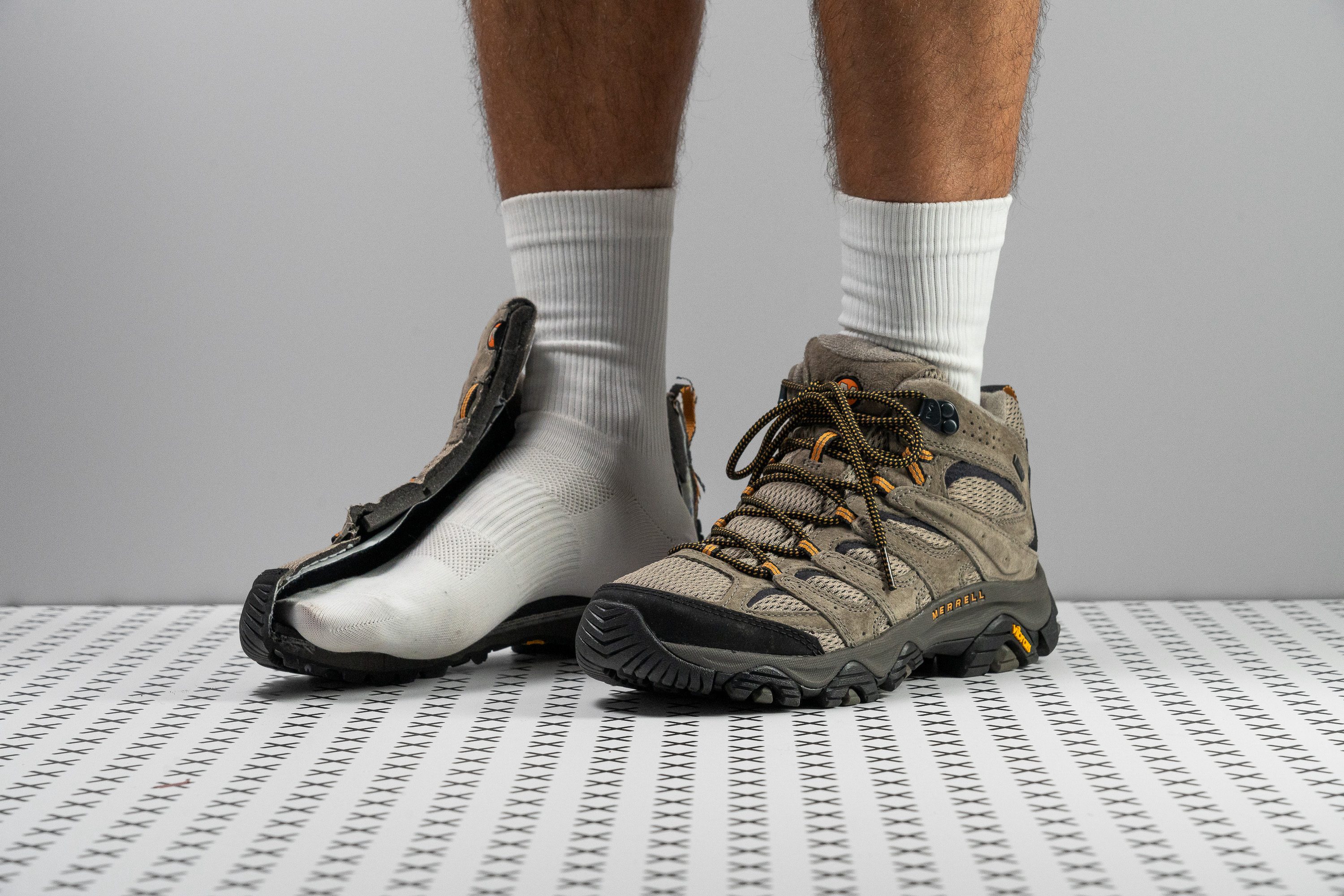






















































What makes it the best?
The Merrell Moab 3 Mid GTX manages to provide effective waterproofing while maintaining a light and manoeuvrable build, making it the best Gore-Tex hiking boot among our roster in the lab. Our feet stayed warm and dry through heavy rains and ankle-deep streams, while the pliable forefoot and Vibram outsole helped us traverse various surfaces with control.
Our lab work verifies the boot is 100% sealed. We sliced the shoe and uncovered two major layers that block off moisture: the Gore-Tex membrane and a thick mesh upper. To test further, we pumped smoke into the shoe, and nothing escaped, confirming its airtight nature with a 1/5 breathability score.
Despite all the added layers, this boot weighs 6.8% lighter than average at 17.5 oz (495g). This minimal build creates a more agile and comfortable ride. In addition, it bends with our feet easily, too! Our flex test verifies that it needs the same amount of force as average to reach 30 degrees (31.8N), making the boot more manageable during rocky or climbing segments since it flows with our foot movement.
For added control, the Vibram rubber is lined with deep 5.0 mm lugs to serve as our brakes during inclined segments.
However, we recorded below-average shock absorption in this boot. Those who prefer a plush sensation over ground feel should look for a more cushioned boot.
Pros
- Best-in-class waterproofing
- Great stability for moderate hikes
- Supportive for all-day wear
- Comfortable step-in feel
- Excellent grip on hard terrain
- Secure lockdown
- Sturdy construction
- Sturdy construction
Cons
- Moderate impact protection
- Mesh panels are easy to tear
- Not for mud or soft terrain
- Moderate impact protection
Gore-Tex hiking boots with the best shock absorption
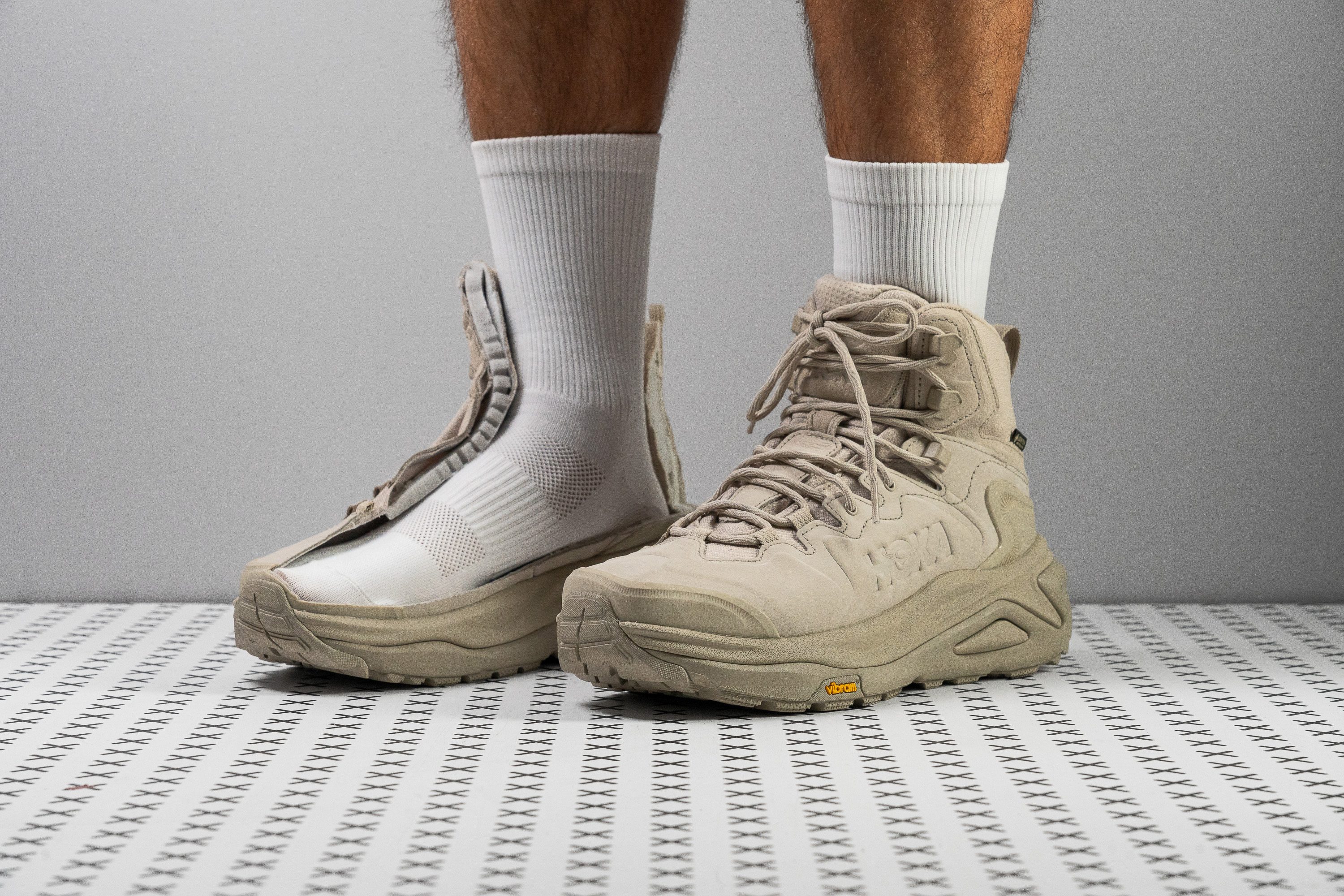
















































What makes it the best?
We raved about the Hoka Kaha 3 GTX having the best shock absorption among Gore-Tex hiking boots after miles of hikes and hours of lab assessments. We discovered it’s loaded with comfort thanks to its protective platform, while its structured and waterproof build ensures our safety in unpredictable weather and terrain.
Using our calliper, we found the shoe’s massive 41.9/30.4 mm height to dampen impact and keep our legs fresh. Testing for its impact protection in the lab, it didn't disappoint with its 120 SA score, 29.0% better than average. It features a SwallowTail heel that smoothens our transitions, enhancing its effortless ride.
Good news for winter and rainy hikers, we found the upper sealed tight since it didn’t let any vapour pass through in our smoke test. Its low 1/5 breathability score cements its effectiveness, which we experienced when we remained dry as we passed through morning dew and shallow streams.
While cushioned boots usually feel unstable, the Kaha 3 GTX kept us surefooted with its wide 115.0/96.4 mm base and high torsional rigidity (5/5). By the end of our long hikes, we still had energy to spare.
However, our Dremel damaged the outsole more than average, which leaves room for doubt in terms of durability. This doesn’t bode well in rocky environments, so we don’t recommend this boot to hikers who predominantly trek on challenging trails.
Pros
- One of the best cushioned boots ever
- Extremely comfortable for long miles
- Highly stable and supportive
- Excellent traction on smooth surfaces
- Grips mixed and hilly terrain well
- Contains sustainable materials
- More streamlined than the Kaha 2
Cons
- Lugs got much shallower
- Heavier than average
Gore-Tex hiking boots with the best ground feel
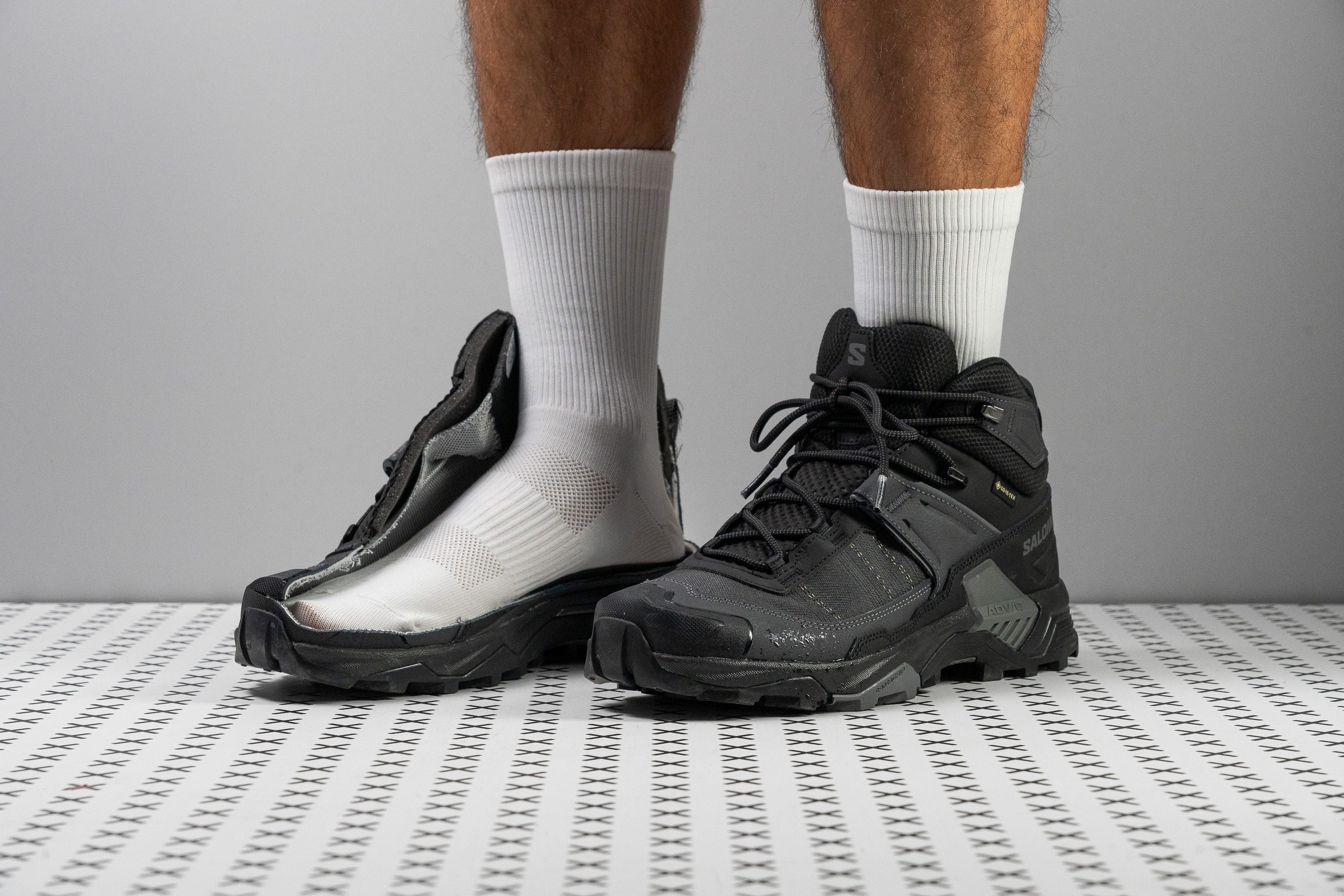











































What makes it the best?
During our treks, we did not feel a single drop of water enter the Salomon X Ultra 5 Mid GTX. What we did feel was raw surface feedback, giving us a strong trail connection and allowing us to manoeuvre quickly with its light and flexible build. With its low profile and minimal impact protection, we verified in the lab that it’s our Gore-Tex hiking boot with the best ground feel.
We measured minimal cushioning in this boot at 32.5/19.8 mm, enough to protect us underfoot without losing trail connection. We measured its shock absorption to be a low 88 SA, which verifies the direct contact we experienced, allowing us to adapt to various situations as needed.
What boosts our agility is the boot’s weightless sensation. It offers a natural ride through its flexible midsole, emerging 34.3% more pliable than average in our bend test. Moreover, its light 15.4 oz (437g) construction never burdened us, reducing stress on our muscles and minimising fatigue.
While we felt much underfoot, we didn’t feel any moisture or cold winds from the upper. With the Gore-Tex membrane and the dense Matryx upper, the boot is sealed tight, proven by its 1/5 breathability score in our smoke test.
Because of its lack of cushioning, we don’t recommend this boot to hikers dealing with foot pain such as plantar fasciitis. The boot’s ride may feel too harsh underfoot for folks with foot conditions.
Pros
- Stable and grounded platform
- Flexible forefoot adds manoeuvrability
- Great grip on wet terrain and rocks
- Surefooted on mixed and hilly trails
- Much lighter than average
- Excellent Gore-Tex waterproofing
- Tough and durable upper
Cons
- Minimal cushioning and shock absorption
- Not for deep mud
Best Gore-Tex hiking boots for backpacking
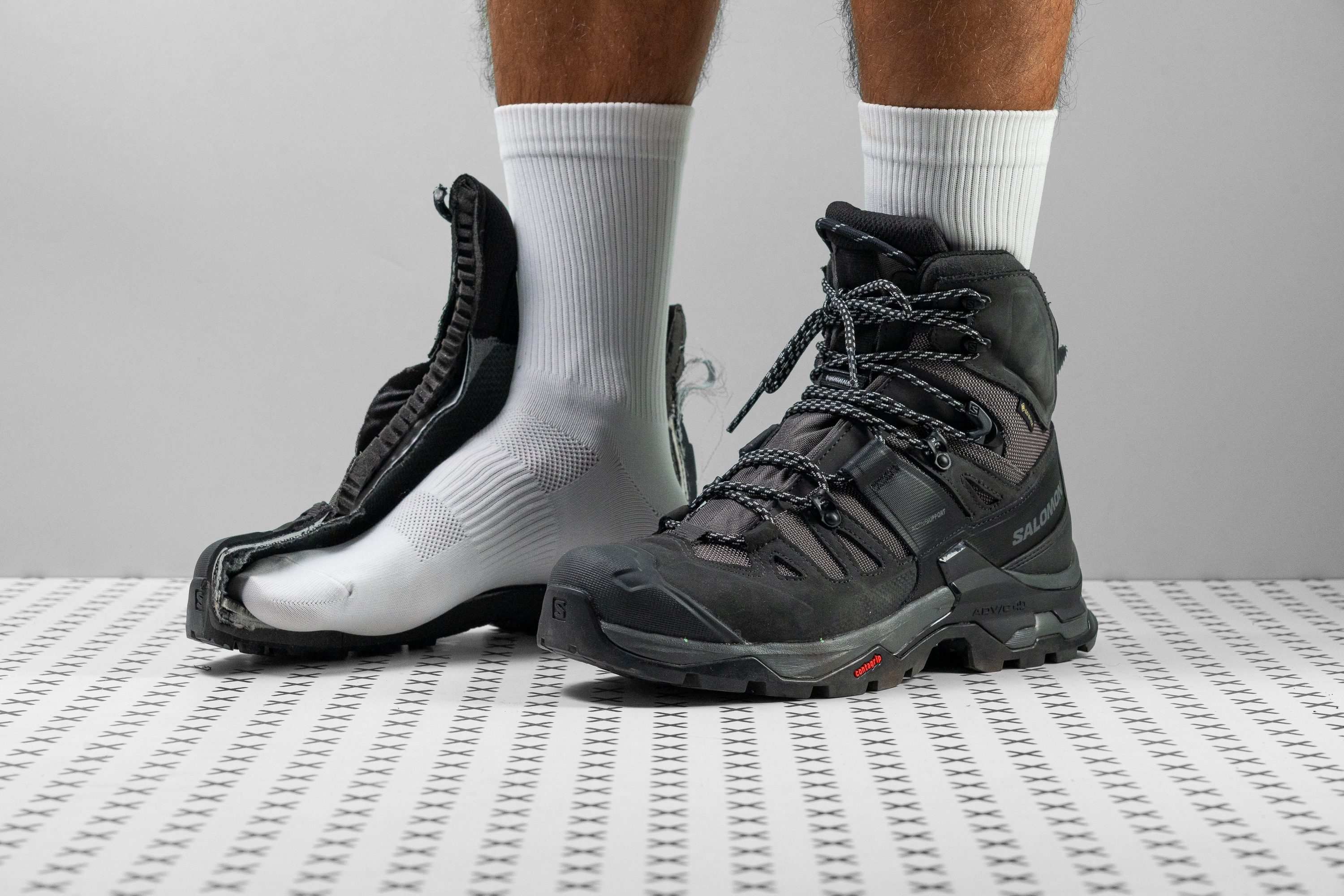















































What makes it the best?
The Salomon Quest 4 GTX is our best Gore-Tex hiking boot for backpacking. Not only is it completely watertight, but also impeccably supportive and durable, making it the perfect companion for long days carrying a heavy load.
This boot is a champion of support, keeping us feeling stable and confident while hiking on rough, rocky trails. Salomon’s integrated support system boasts unparalleled lockdown and stability, and we couldn’t roll our ankles if we tried! In the lab, we bent and twisted the shoe, finally rating it 5/5 - the stiffest rating possible for torsional flexibility. On the trail, we found that even with a heavy pack, the stiffness in the midsole prevented us from twisting and injuring our foot.
With its multiple overlays made from rubber, nubuck leather and a robust Cordura-like fabric, this boot means business. It looks as tough as nails, and it survived our test hike without damage too, so we put it to the test in the lab. We applied a Dremel at a force of 3.2N and 5K RPM for 12 seconds on the toe. It left only a small scratch on the upper. We tried a similar test on the outsole, only this time at 10K RPM for 22 seconds - the resulting damage to the lug was less than a millimetre deep. If we needed any proof of the Salomon Quest 4 GTX’s durability, this is it!
No backpacker wants wet feet during their thru-hike as we all know how uncomfortable wet boots are after several days. The Gore-Tex membrane resists rain for hours on end and river crossings are a piece of cake. The fully gusseted tongue prevents water and debris from sneaking into the boot, and the high collar makes it possible to cross deep puddles and streams without water flowing in. On rainy days, the 4.7 mm lugs gripped well in mud, and we found the wide spacing between the lugs made it easy to shed, increasing our grip.
Backpackers who spend a lot of time hiking in winter will want to know that this boot is very rigid in winter! We put it in the freezer for 20 minutes before testing it for flexibility once again. While most hiking boots stiffen up by 24%, this one became 37% stiffer. There is no doubt that this is a rigid shoe in the cold, and it will need some breaking in on cold days. We don't recommend it to hikers looking for a flexible cold-weather boot.
Pros
- Exceptional durability
- Top-notch waterproofing
- Excellent underfoot protection
- Highly secure ankle support
- Fantastic stability
- Comfortable in-boot feel
- Effective grip on various terrain
- Fits as expected
Cons
- A bit heavy
- Gets very stiff in cold
Best Gore-Tex hiking boots for technical terrain
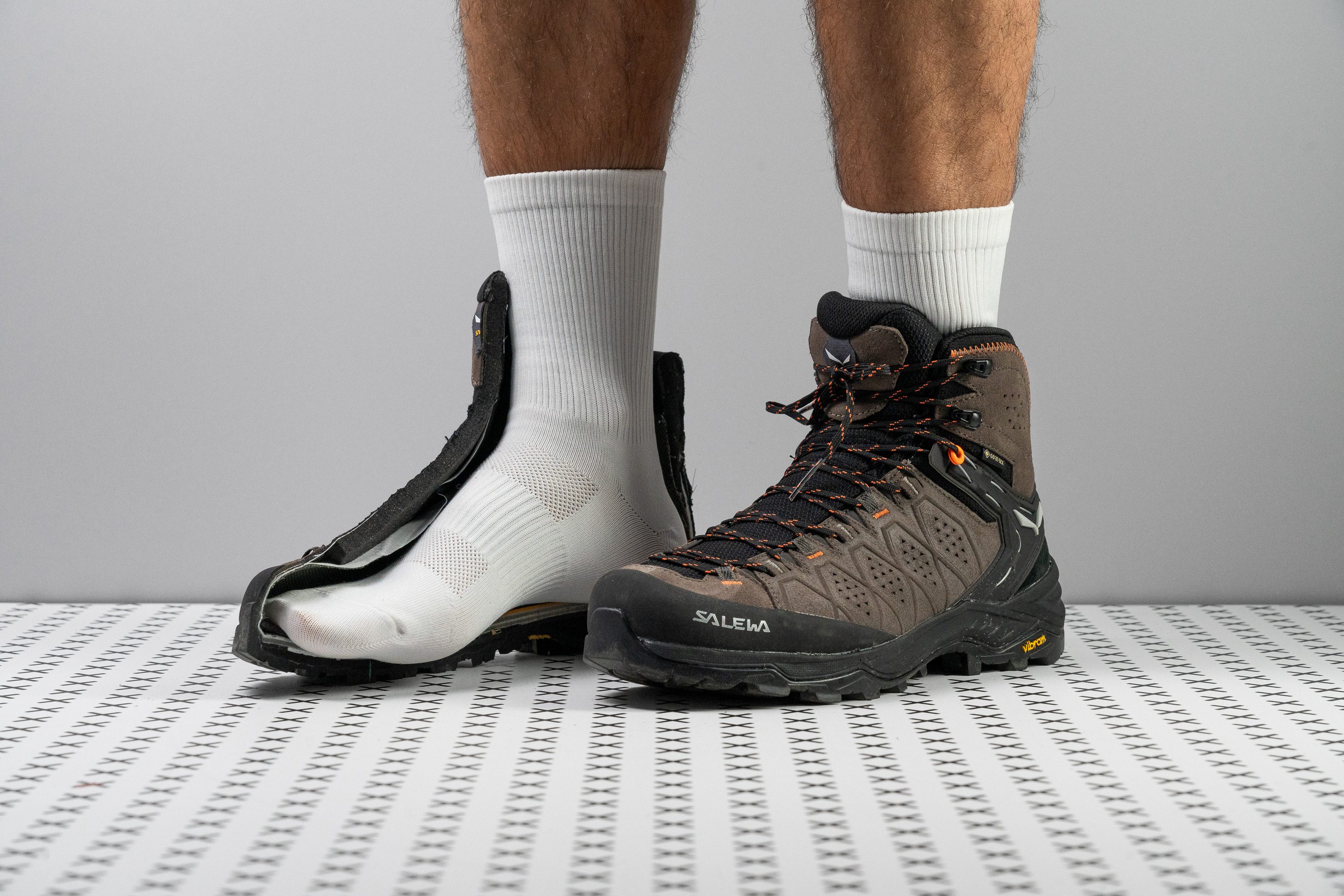












































What makes it the best?
Salewa Alp Trainer 2 Mid GTX is a heavy-duty boot that can handle whatever the weather or trails bring in our treks. From its sturdy build, watertight upper, and unmatched traction, lab tests show it’s the Gore-Tex hiking boot that can handle technical terrains best.
Whether tackling rocky paths, loose ground, or steep climbs, the boot's aggressive lugs can handle the harshest surfaces with ease. We measured them to be 5.2 mm deep, toothier than average, and designed strategically to offer unmatched traction. Testing for durability, our Dremel only shaved off a minimal 0.6 mm dent, proving the outsole’s protective nature.
The boot has a solid construction that offers undeniable lateral containment and ankle support. The midsole has a stiff internal shank that generates tonnes of torsional rigidity to prevent our feet from collapsing. True enough, it had no give to our manual twist test, resulting in the maximum 5/5 stiffness score.
The upper features the Gore-Tex Extended Comfort membrane, which effectively shields our feet from cold winds and water. With the boot’s fully-gusseted tongue, its flood level is high. In our smoke test, we verified that the interior of the boot is hard to access with its 1/5 breathability rating.
However, all the protection and support bulked the boot up to 19.2 oz (542g). Hikers who prioritise agility in the mountains should go for a lighter shoe.
Pros
- Fantastic stability on challenging trails
- Extra strong grip on technical terrain
- Secure lockdown and ankle support
- Exceptional durability
- Excellent waterproofing
- Great underfoot protection
- Flexible collar is handy on descents
- Fit can be regulated with an insole
Cons
- Drop is twice as high as stated
- Collar lining lacks durability
- Collar lining lacks durability
Gore-Tex hiking boots with the best support
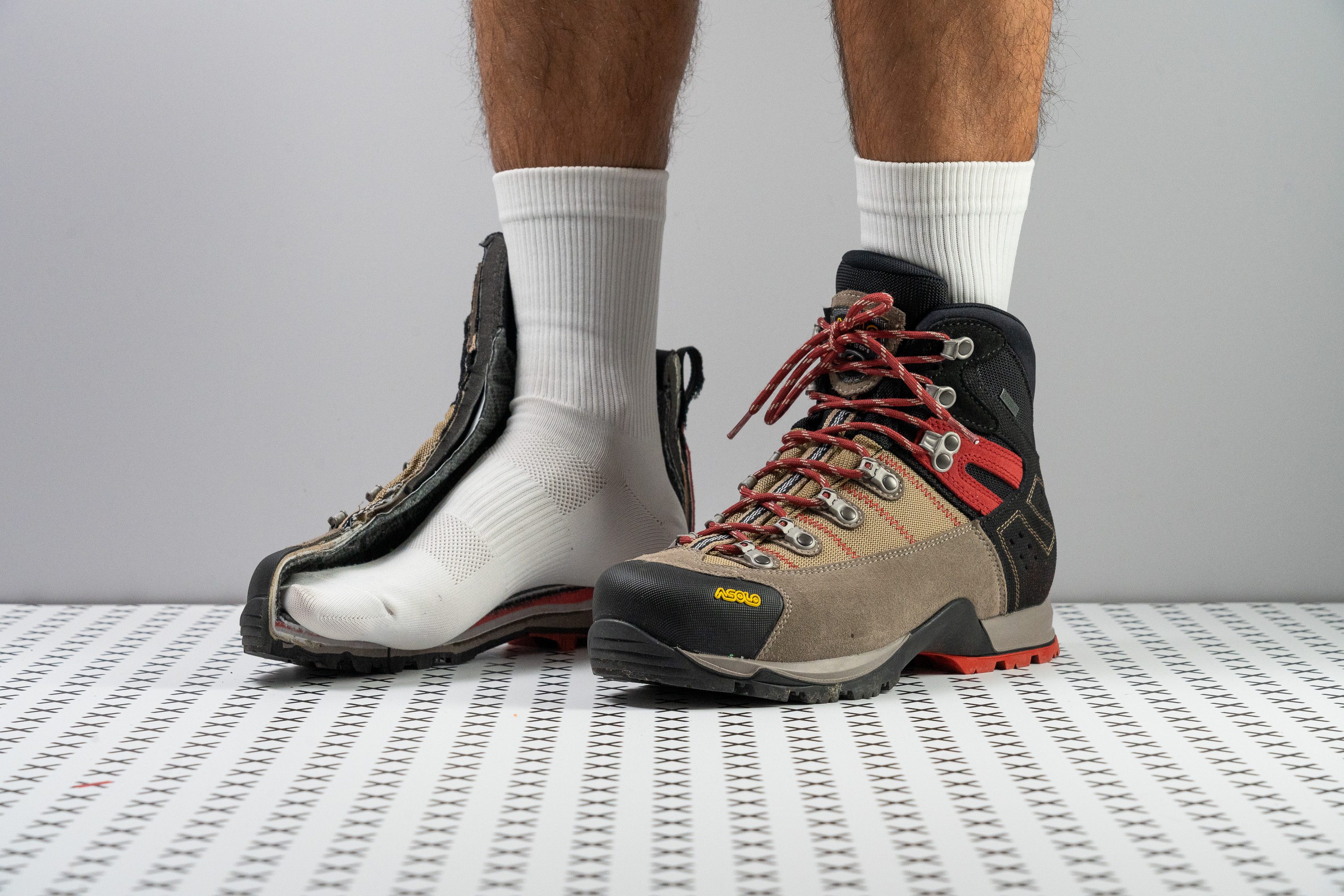



















































What makes it the best?
Backpacking in the wilds in the Asolo Fugitive GTX is a dream. Among Gore-Tex hiking boots we tested in and out of the lab, we found Fugitive GTX to offer the best support. This boot is all about safety and protection with its water-repellant upper, firm cushion, rigid build, and patterned midsole.
The Gore-Tex lining in this boot is second to none, and our feet stayed dry all day, even after multiple stream crossings. Looking through our microscope revealed a tight braided mesh upper, which ensures unwanted debris will stay out. In addition, the tongue is fully gusseted and the collar stands high, preventing rain and stream water from sneaking in.
Every step feels surefooted as we tackle rocky and steep paths. The firm cushion enhances stability and protects our feet from sharp objects. Our durometer confirms the foam is 34.0% firmer than average. Further avoiding awkward ankle rolls is the rigid platform that doesn’t bend easily to protruding roots.
The patterned outsole is a champion of traction, with its variously-shaped lugs. We experienced excellent grip on loose ground, snow, mud, and wet rocks.
A backpacking boot of this calibre is a heavyweight champion. Weighing in at 24.8 oz (704g), it is 7.2 oz (204g) heavier than the average hiking boot. Those looking for a lighter option may want to look elsewhere.
Pros
- Great grip on mixed terrain
- Fantastic underfoot protection
- Worth the price
- Waterproof
- Reliably supportive
- Feels light on the foot
- Zero break-in
- Balance preserver
Cons
- Outsole started peeling off
- Not-so-cushy footbed
Best lightweight Gore-Tex hiking boots
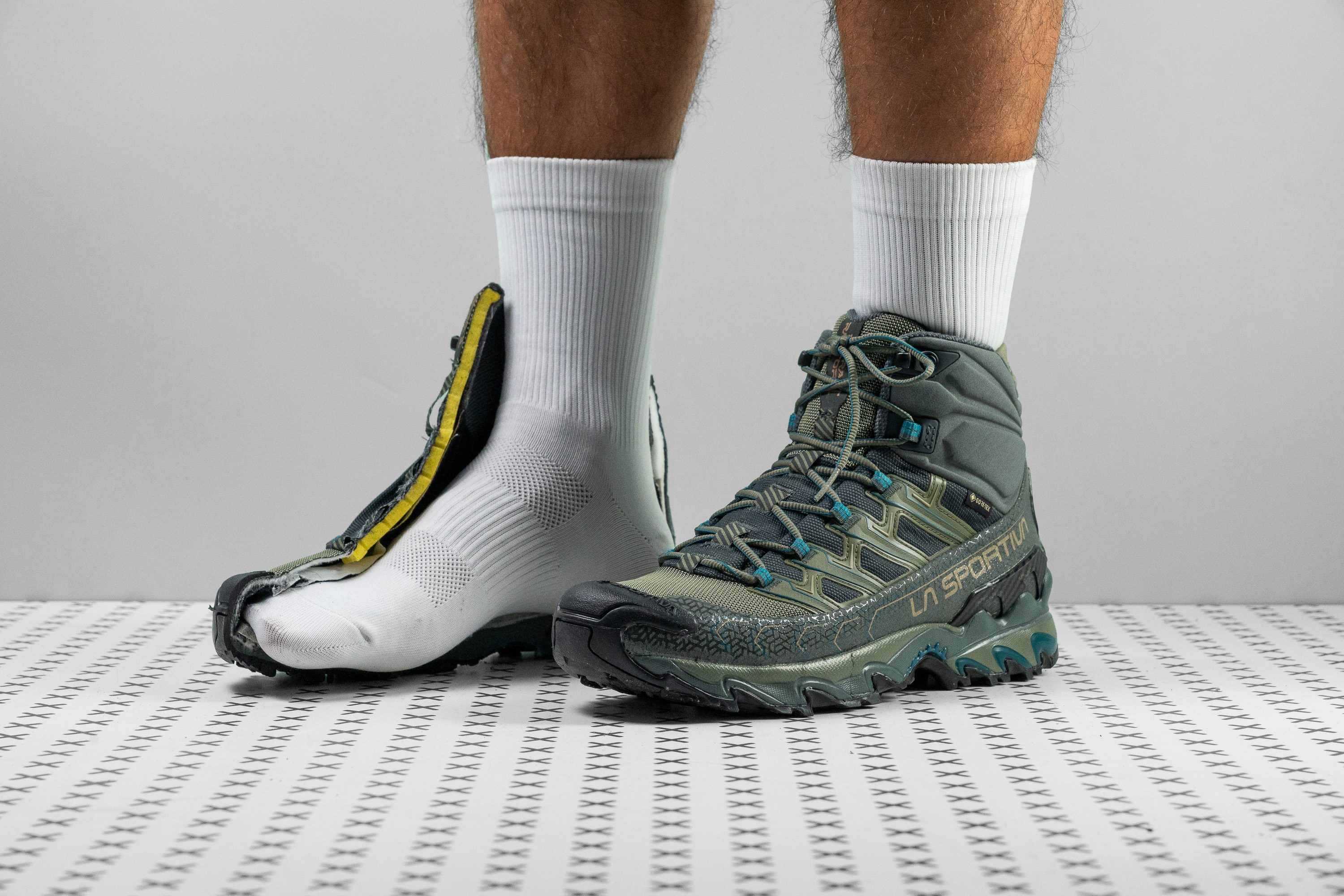















































What makes it the best?
Backed up by the lab results and trail escapades, La Sportiva Ultra Raptor II Mid GTX is our top lightweight Gore-Tex hiking boot. Its airy and flexible construction almost feels like a trail shoe with the added support and protection of hiking boots.
This hiker registered a mere 14.6 oz (415g). Compared to the average hiking boot, it sheds a mind-blowing 21.8% of weight! Its lightness enhances our quick movements, making sustained, faster paces more effortless. Its flexibility adds to its easy feel, emerging 14.6% more bendable than average in our 30-degree test.
There is no trouble in getting ourselves into drizzly and damp situations, as the Gore-Tex material perfectly shields our feet from water. Its low 1/5 breathability score in our smoke test verifies its sealed waterproofing.
The midsole has high resistance to twisting, which made us feel stable even when the terrain got more extreme. In our torsional rigidity test, it received the maximum 5/5 rating, which grants us steadiness in our hikes.
Its streamlined toebox feels tight, so we can’t recommend this boot to hikers seeking a roomy fit.
Pros
- Unbelievably lightweight
- Excellent waterproofing
- Doesn't let debris and falling rain/snow inside
- Exceptionally robust and durable
- Phenomenal grip on technical terrain
- Not so stiff and firm in low temperature
- Sufficient impact protection
- Highly supportive collar
- Ample flexibility
Cons
- Narrow platform
- Not for wide feet
How to recognise Gore-Tex hiking boots
Just look for the Gore-Tex sign on the boots or on their box. Brands usually write GTX in the boot name as well.
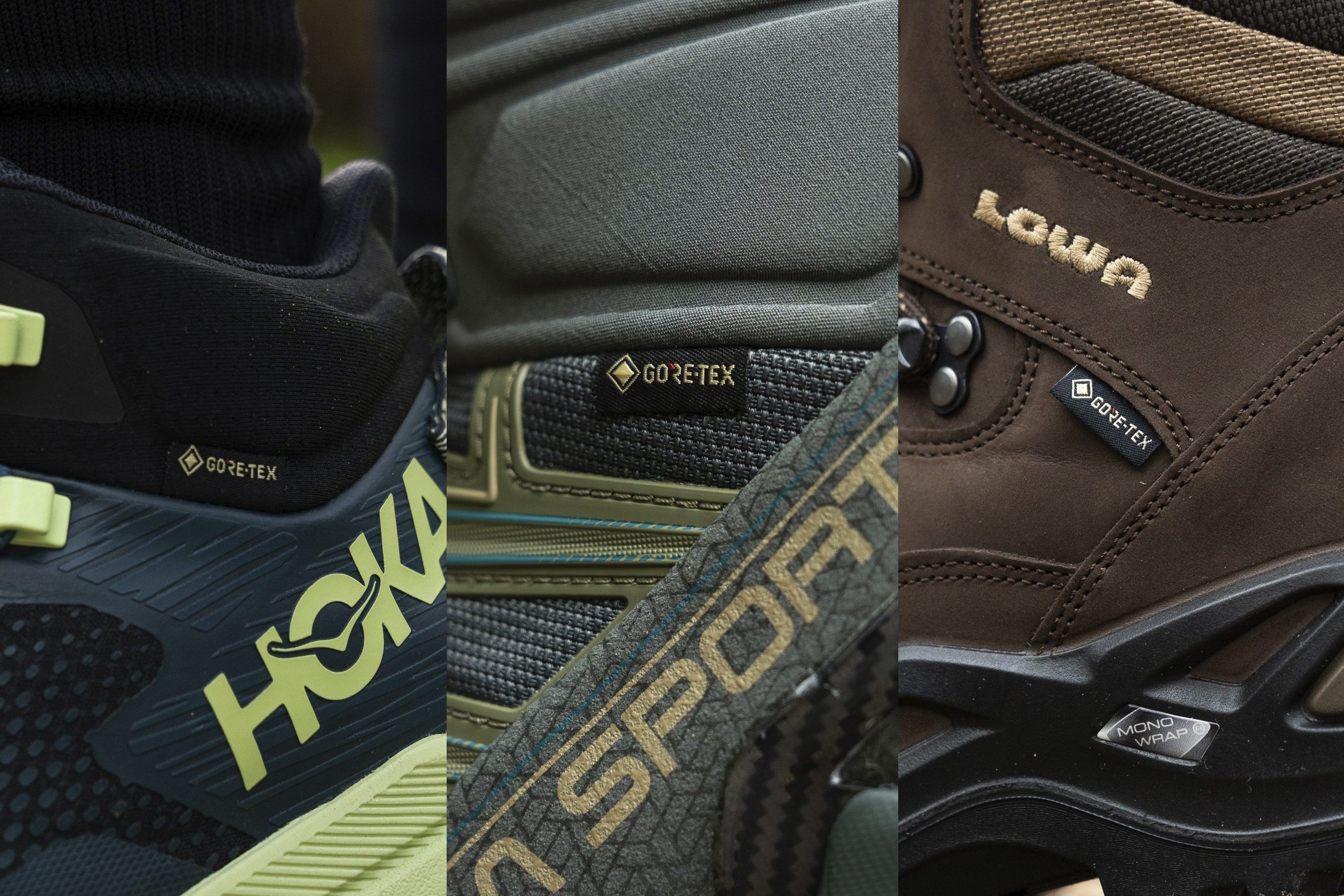
What to expect from Gore-Tex hiking boots
Hiking boots that are equipped with Gore-Tex are:
- Waterproof
- Not so breathable
- Usually more expensive than boots with no waterproof membrane.
When we test GTX hiking boots, we make sure to wear-test them in wet conditions to check the level of waterproofness.
When it comes to prices, at the moment of writing this guide, the average price of GTX hiking boots was £220.5, while the average price of non-waterproof hiking boots was £200.2.
Poor breathability of GTX hiking boots
When we take the boots to the lab, we measure the breathability. We pump the smoke into the boot and wait for the smoke to come out. In GTX hiking boots, it does not come out or at least not where we’d want it for a boot to be great at breathability. In breathable footwear, the smoke comes out through the upper: the toe box, the sides, maybe even the tongue.
Based on this test, we rate the breathability on a 1 to 5 scale, where 5 is the most breathable.
What prevents these boots from breathing more is the GTX layer which is usually laminated. When we cut the boots in half, we can easily see that layer.
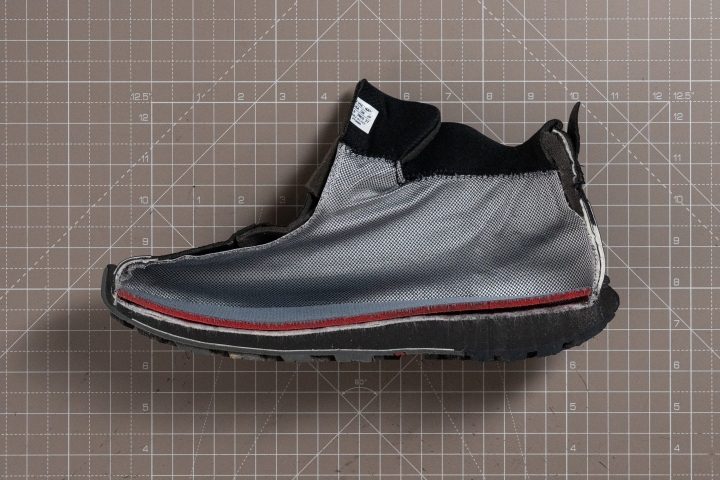
We also examine the upper under the microscope.
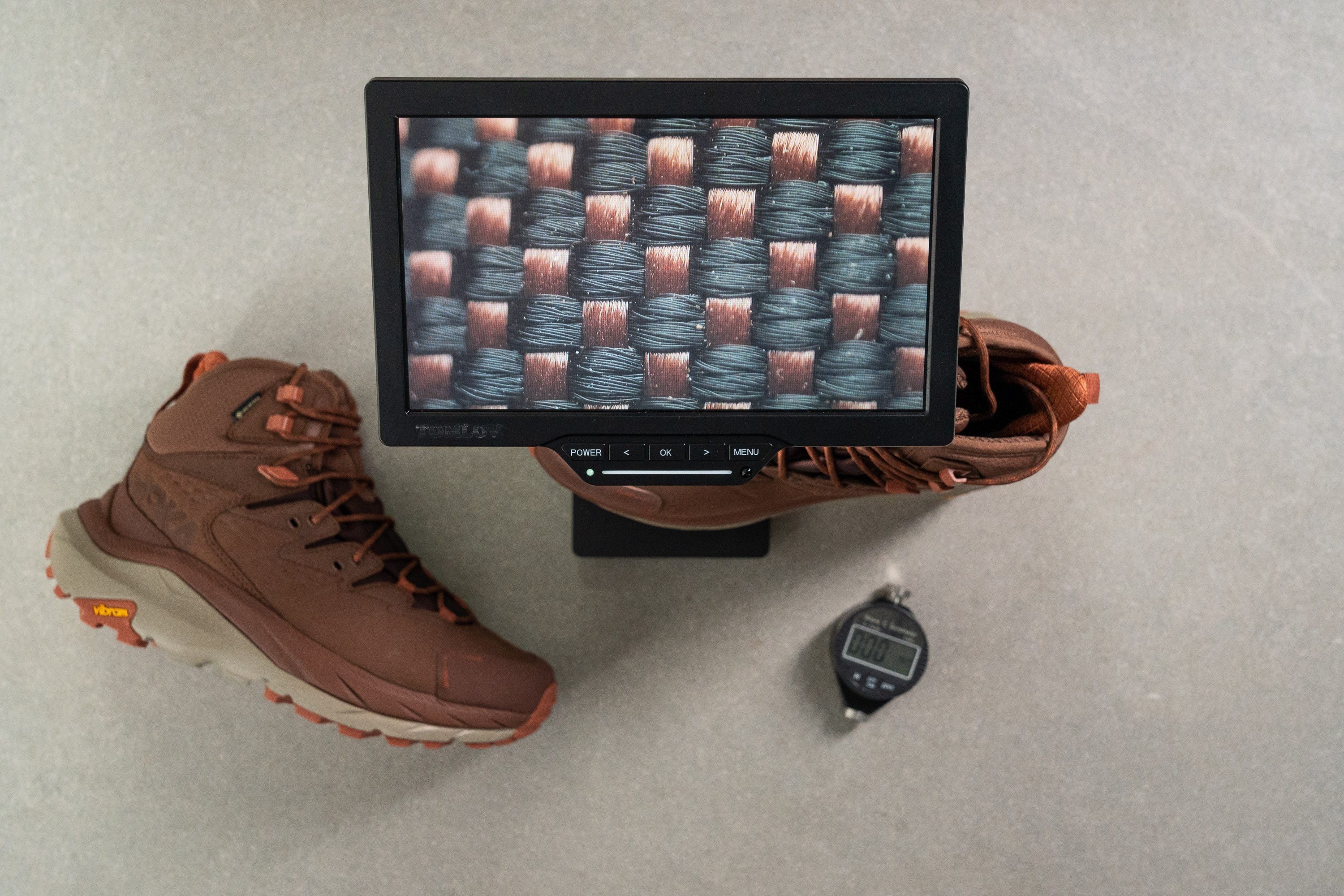
This just confirms our breathability ratings because we get to see how tight and dense GTX uppers are, unlike the non-waterproof ones where we’re able to see looser threads and sometimes even vent holes.
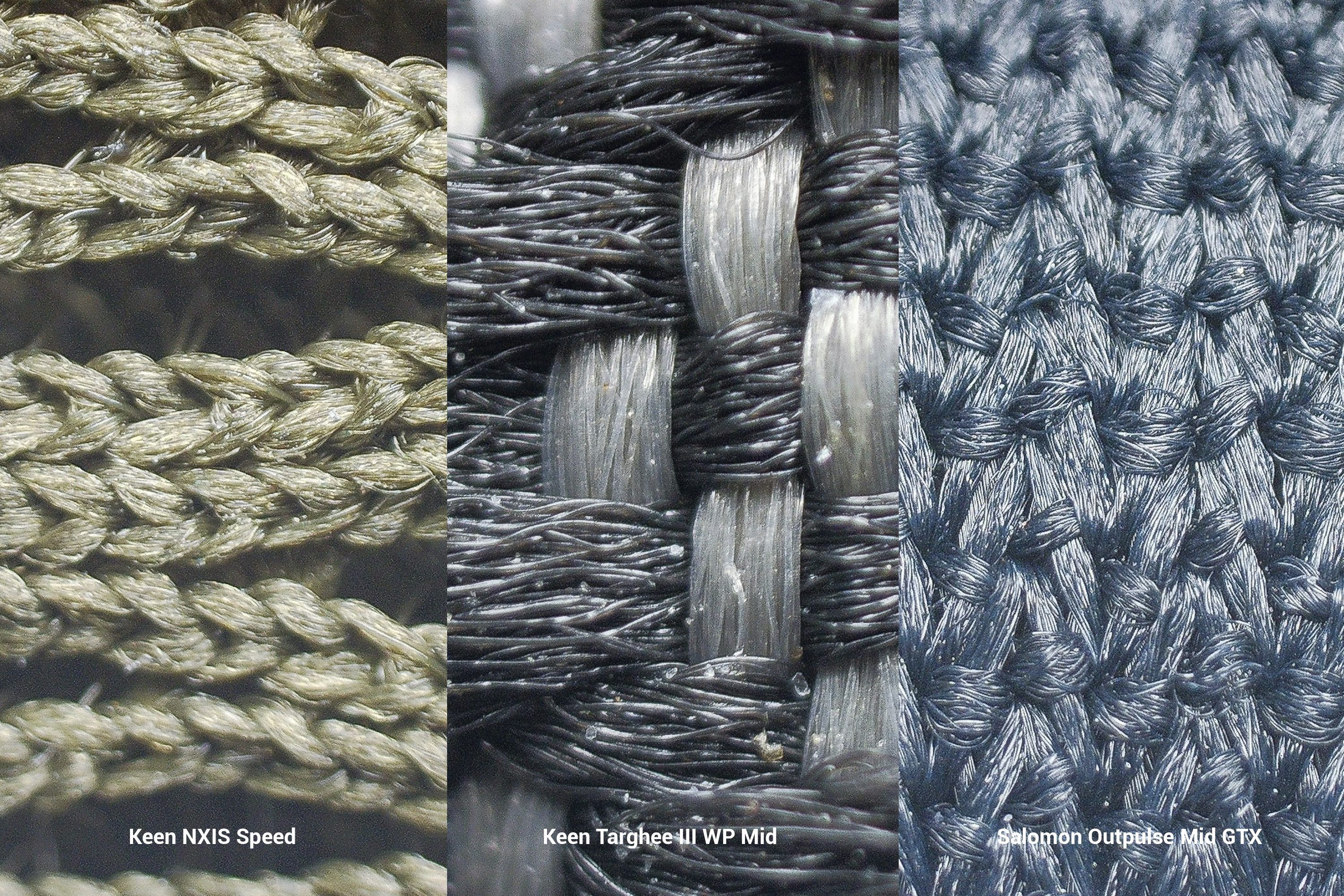
The downside of GTX hiking boots
As mentioned above, these boots are not breathable. So you should make sure you really need them or be cautious when wearing them. We’re saying this because: if water gets inside of your boots somehow, it is almost impossible for it to get out. The boots are not breathable enough for the heat of your feet and perspiration to vent the water out. And hiking in wet boots is uncomfortable, at least.
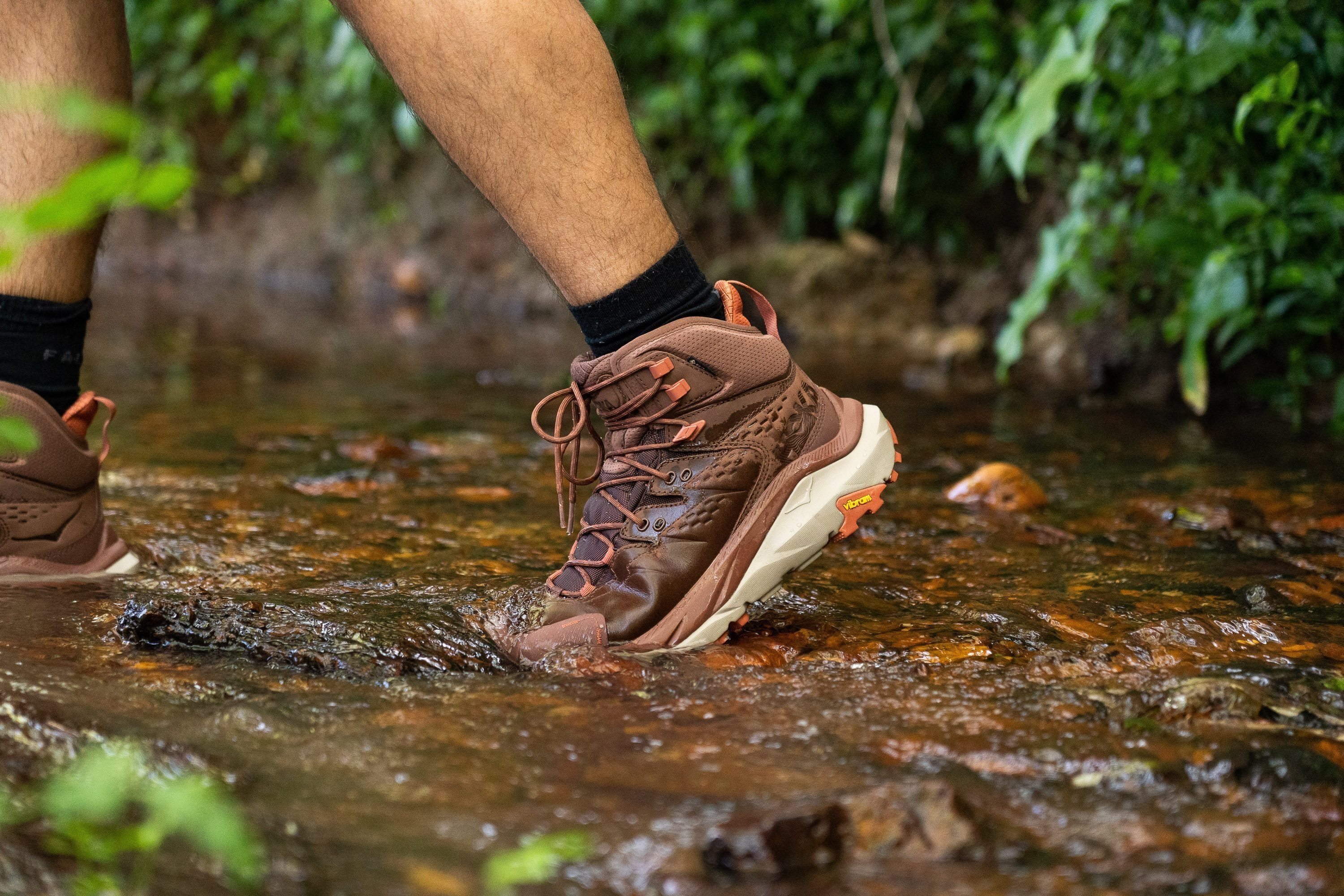
What you can do is get waterproof (maybe GTX) gaiters. Ideally a knee-high pair that will prevent the water from getting inside of your boots.
Also, when hiking in non-breathable hiking boots, it’s best to wear moisture-wicking socks. We recommend those made of wool or bamboo.
Grippy, not slippery! Traction in GTX hiking boots
Hiking in wet weather means dealing with rain, snow, mud.
You should consider this before buying the GTX boots as different lug depths allow for different grip:
- Very deep lugs, 4mm and deeper, are best for mud and snow. If hiking in mud, best if the lugs are spaced further apart to allow mud shedding.
- Average lugs, around 4mm, are usually found on versatile boots which means you can cover a bit of everything.
- Shallower lugs (<4mm) can be used on hard ground like large flat rocks.
When testing hiking boots in our lab, we measure the thickness of the lugs with a calliper. You can always find that number in our hiking boot reviews.
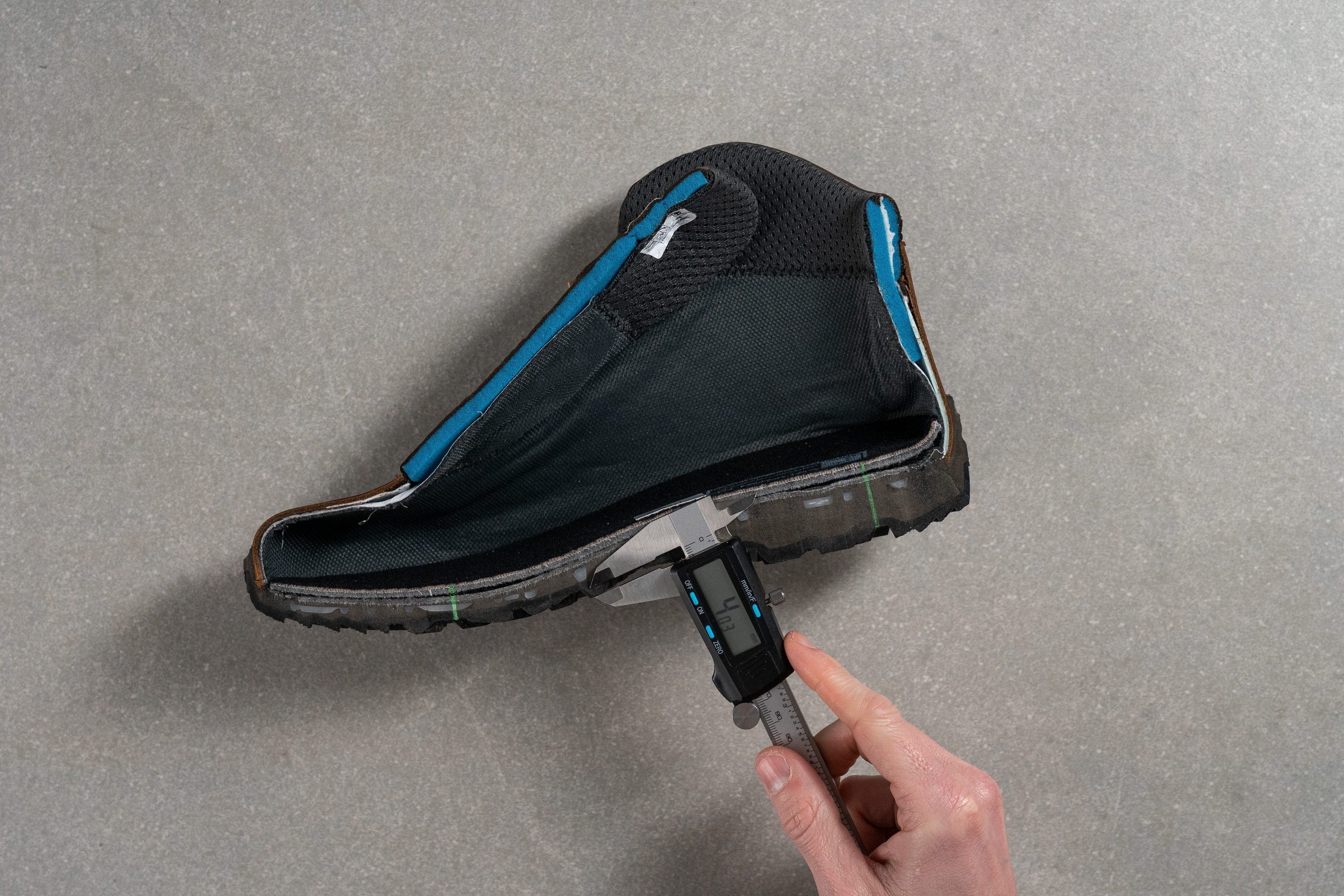
However, the hardness of the outsole rubber also plays a role in traction. Softer rubber is usually stickier and harder rubber is more durable. We also measure this in our lab.
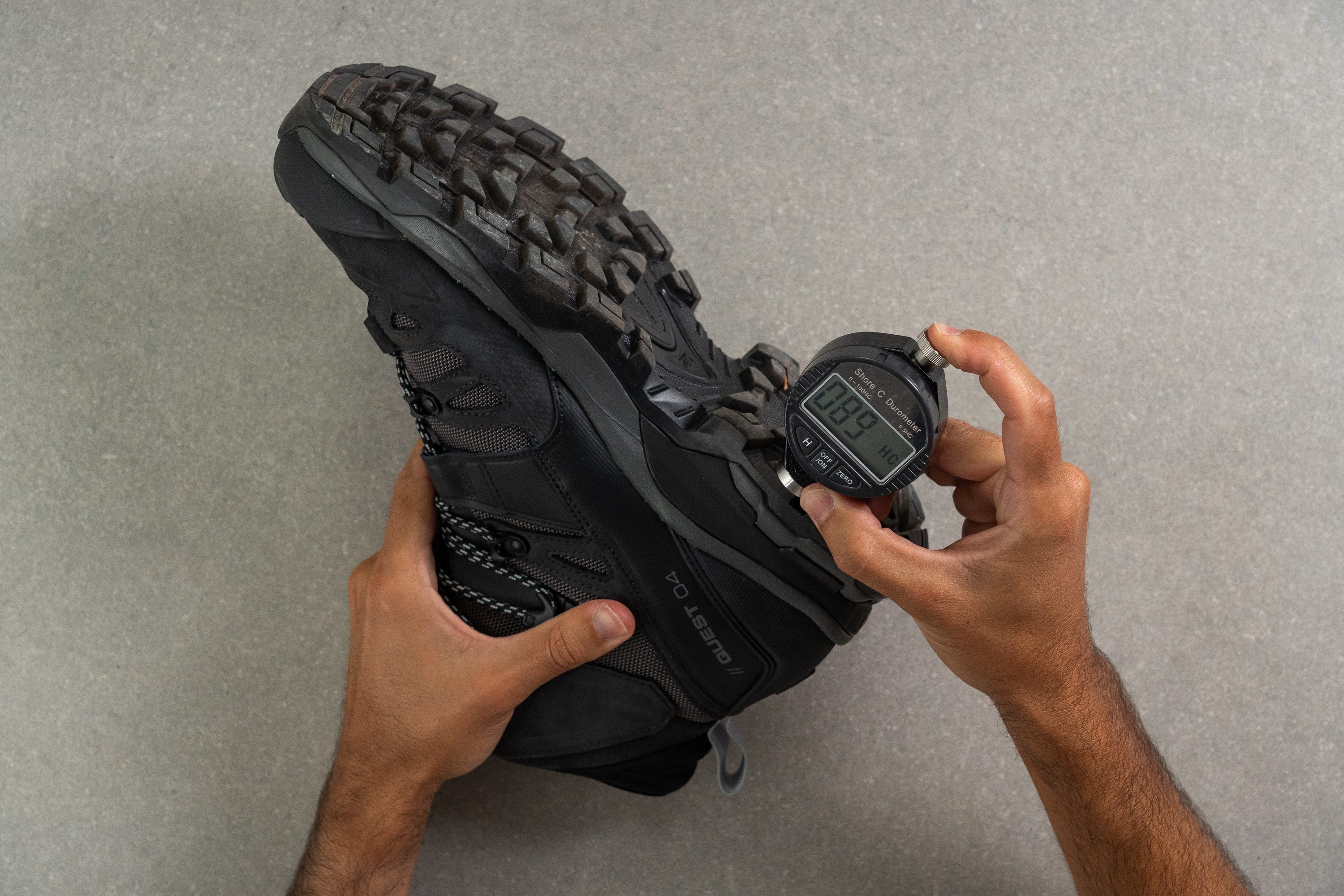
How durable are Gore-Tex hiking boots
Because we tested GTX hiking boots for different purposes, terrain, and from different brands their durability varies.
We test durability in 3 places: on the toe box, heel collar, and outsole. To test durability of footwear, we use a Dremel.
We standardise tests which means we always use the same pressure, RPM and time needed to do the test.
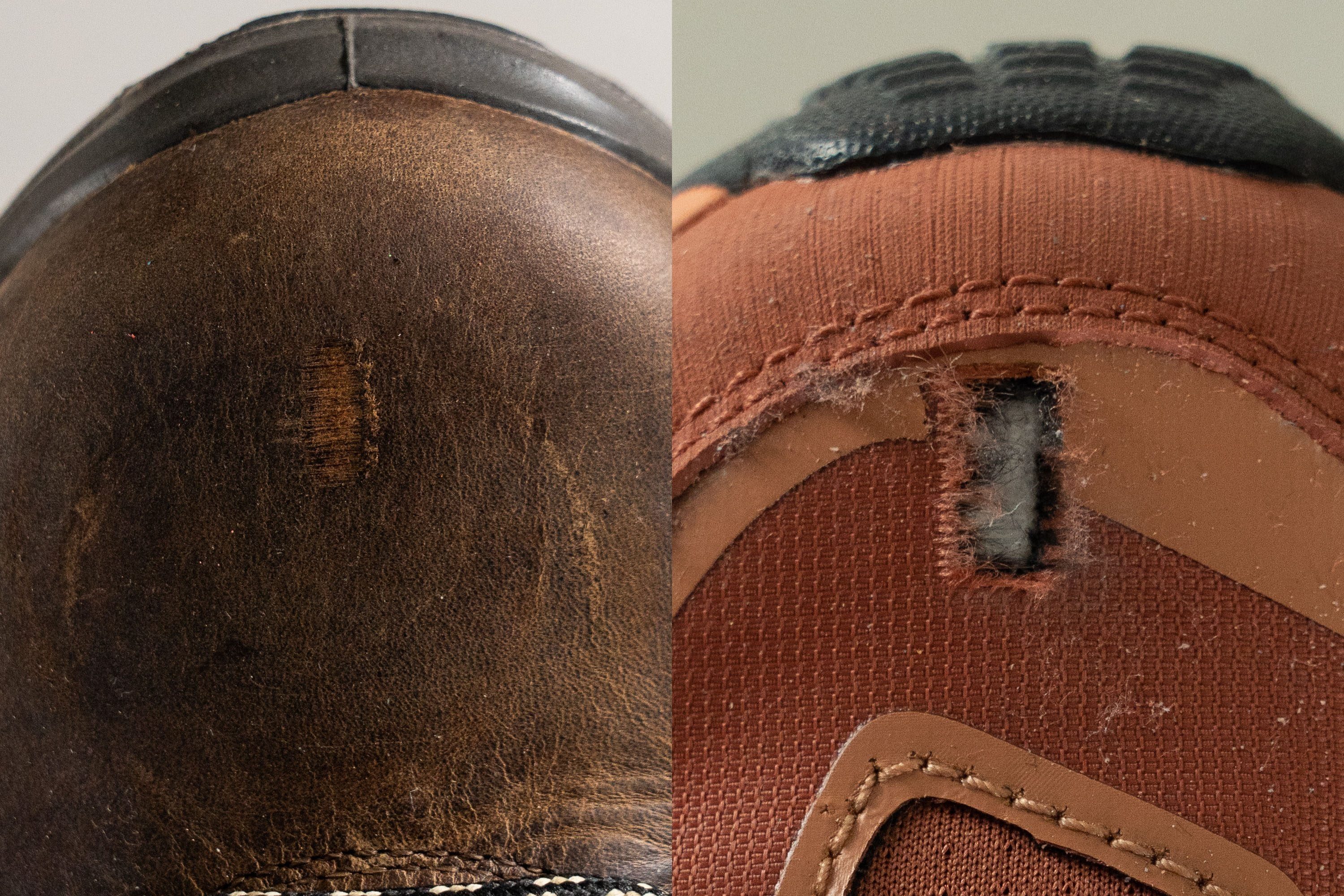
When testing the durability of the heel collar and the toe box, we visually assess the damage our Dremel has made. We rate the durability with a number from 1 to 5, where 1 is the least durable (we would see big damage).
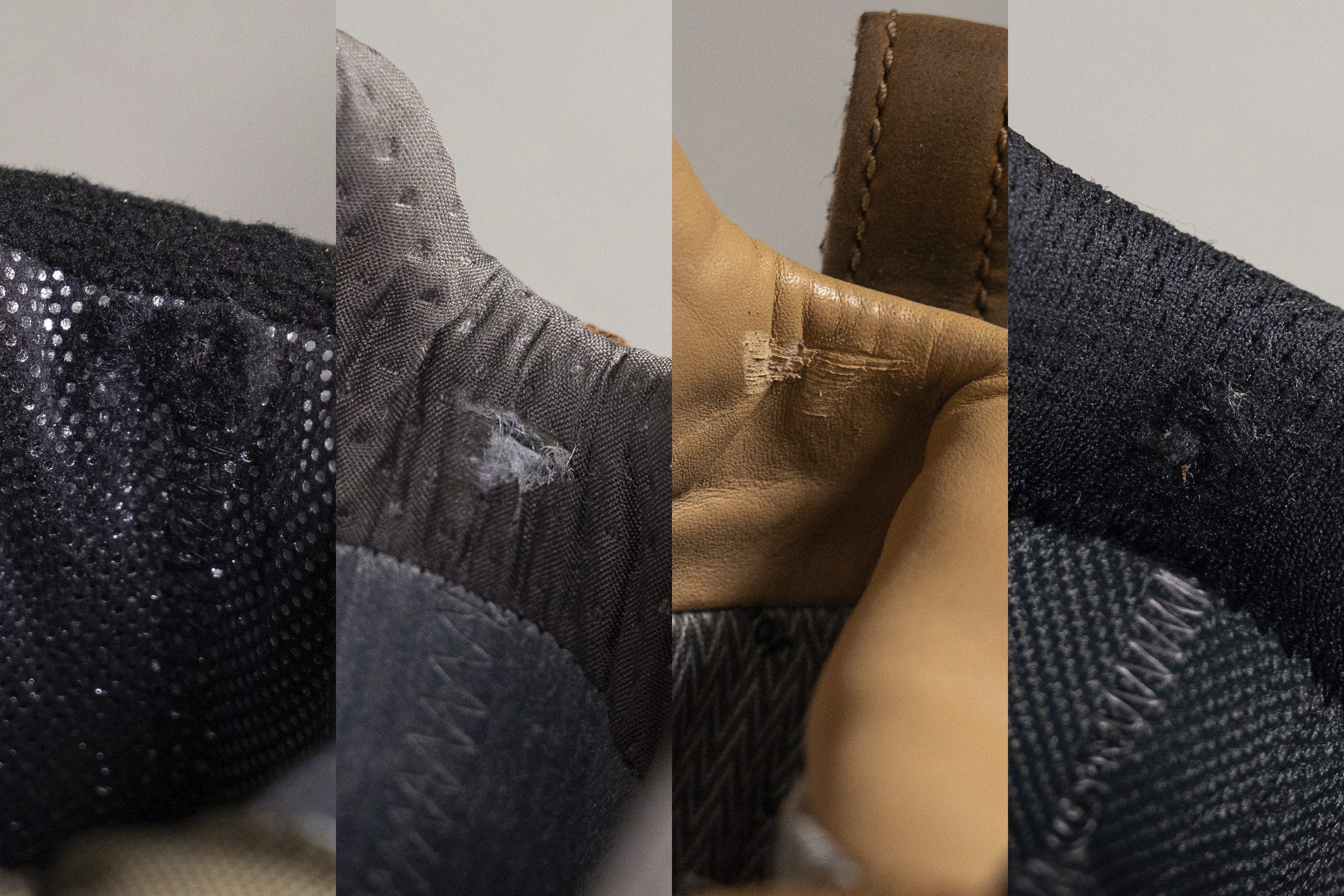
However, when doing the test on the outsole, we’re able to precisely measure the depth of the dent our Dremel has made.
We do it using a tyre tread gauge. The shallower the dent, the more durable the outsole!
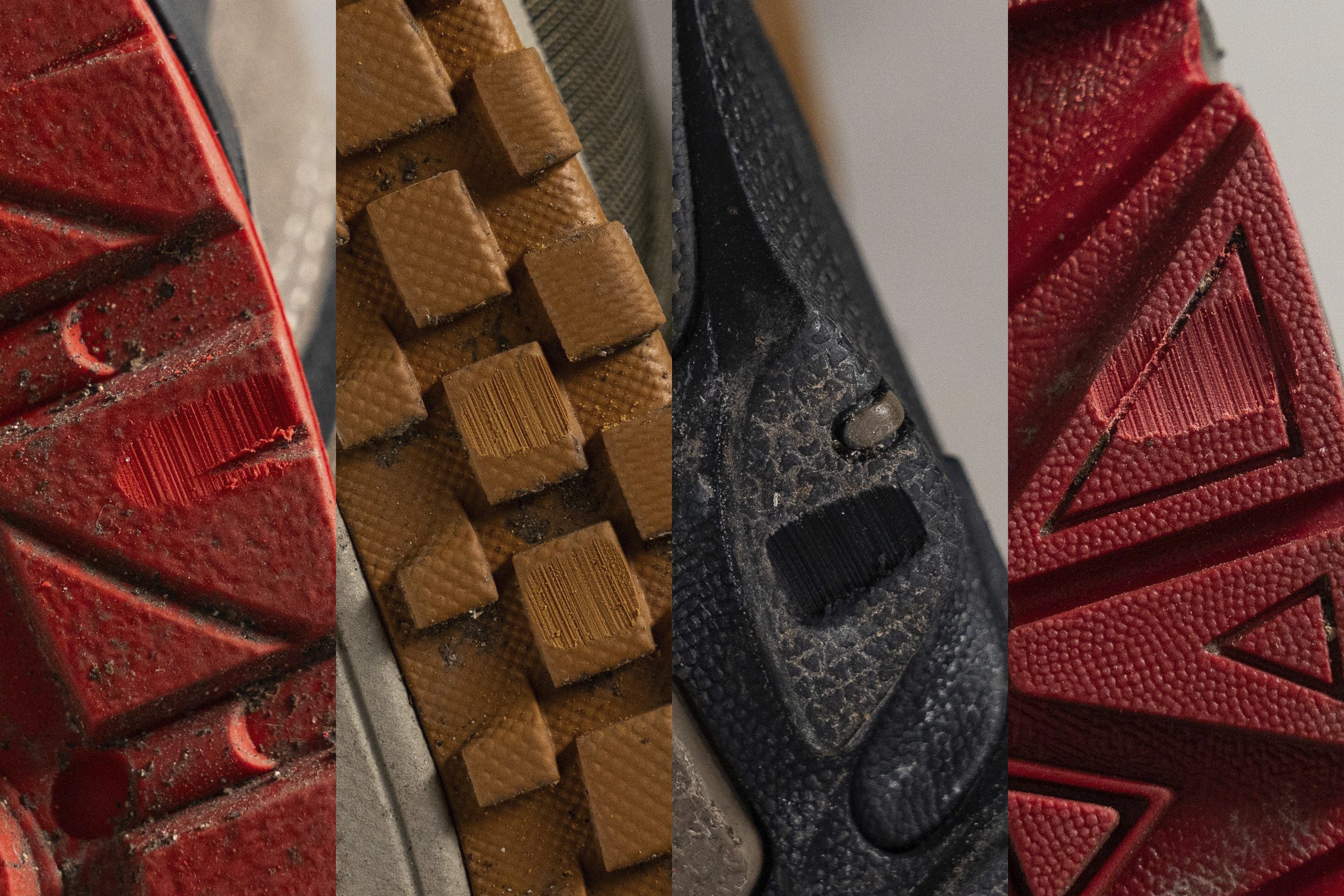
Finally, here’s how top GTX boots in our database got rated for the durability:
Flexibility of GTX hiking boots varies
Hiking in wet weather means you want all the stability you can get. Sometimes, that means using stiffer hiking boots that keep their “form” when covering uneven surfaces covered with sharp rocks or debris. This is especially important when the terrain is wet and you don’t want to slip.
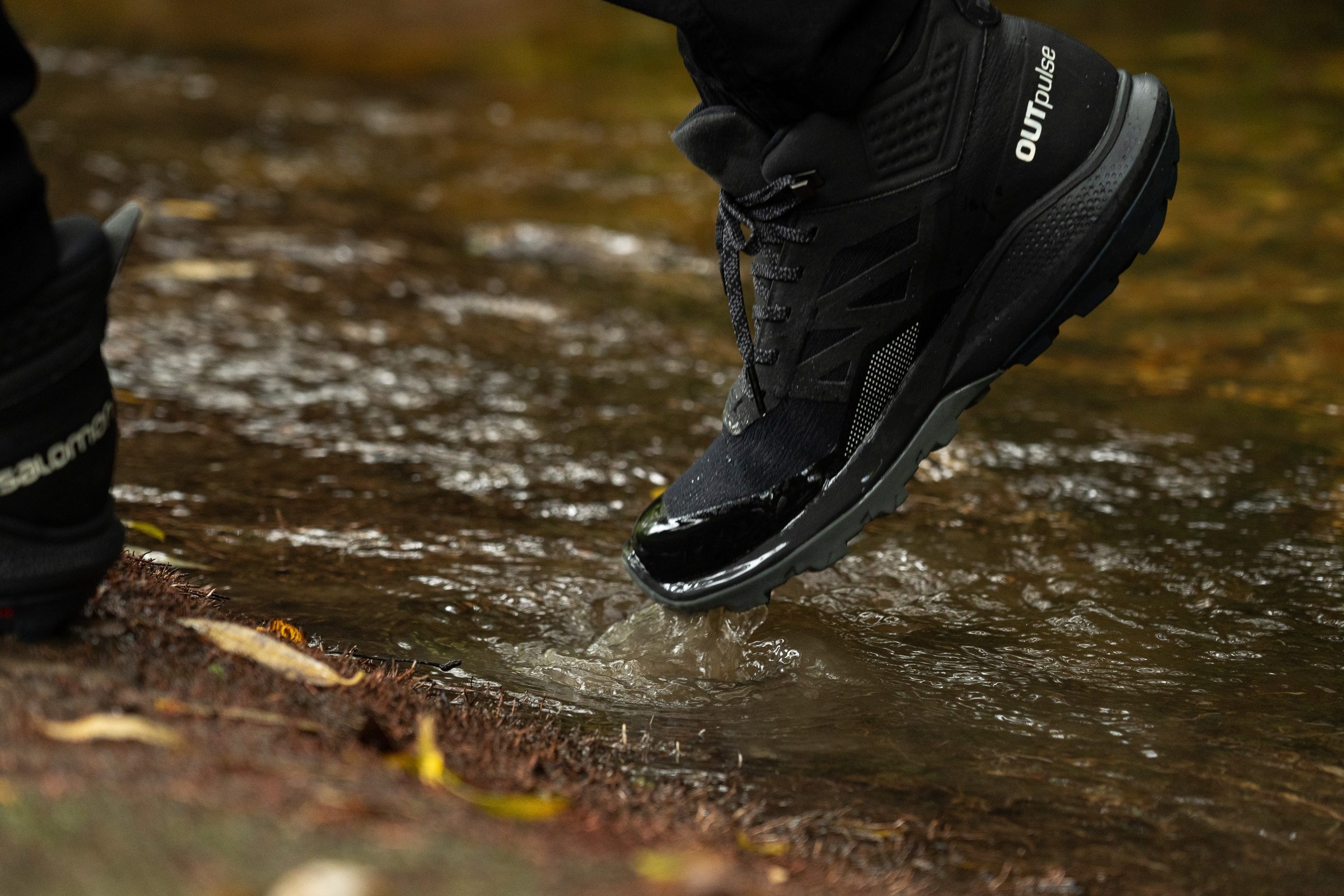
On the other hand, more flexible boots are better if you plan to do speed hiking, because they allow for a more natural foot movement as they bend with the feet.
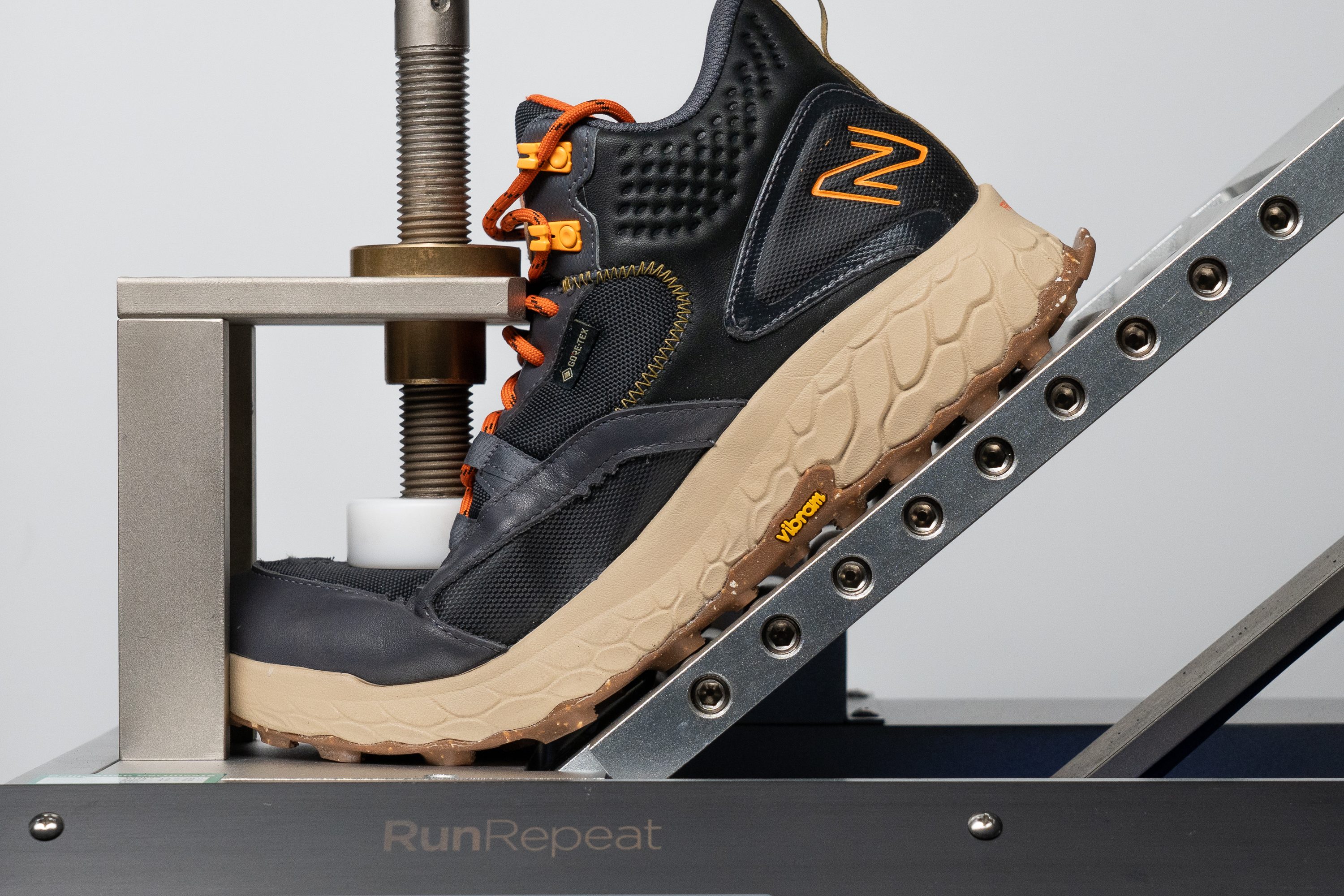
We test the stiffness of hiking boots in our lab. We clamp the forefoot and push the heel to 30 degrees, after adjusting the starting position of the plate so that the heel rests on it. The more force we need to do this, the stiffer the boot.
We also try to twist the boots in our hands and we assess the torsional rigidity this way, on a 1-5 scale, where 5 is the most rigid.
Proper fit in Gore-Tex hiking boots
If this is you, buying your first pair of hiking boots, we recommend sticking to these guidelines to ensure a good fit:
- Go boot shopping later in the day, in the evening or in the afternoon. By then, your feet are most likely swollen a bit and it’s just what we need because similar swelling happens on the hike.
- When trying the boots on, use the socks you plan to hike in and orthotics, if you’re using them.
- Lace the Gore-Tex boots up and sense if there are any hot spots. There shouldn’t be any. Boots should feel comfortable, not too snug and not too wide.
- There should be a thumb’s width of space in front of your toes when you pull the heel to the back of the boot.
- Use the ramp that most specialised stores have - covered with different materials, artificial grass, pebbles, large rocks. Walk up and down. Your feet should not slide inside the boot from side to side and there should be no heel slipping.

And, keep in mind, many hiking boots must be broken in before their regular use. Do that to ensure pain-free hikes.

